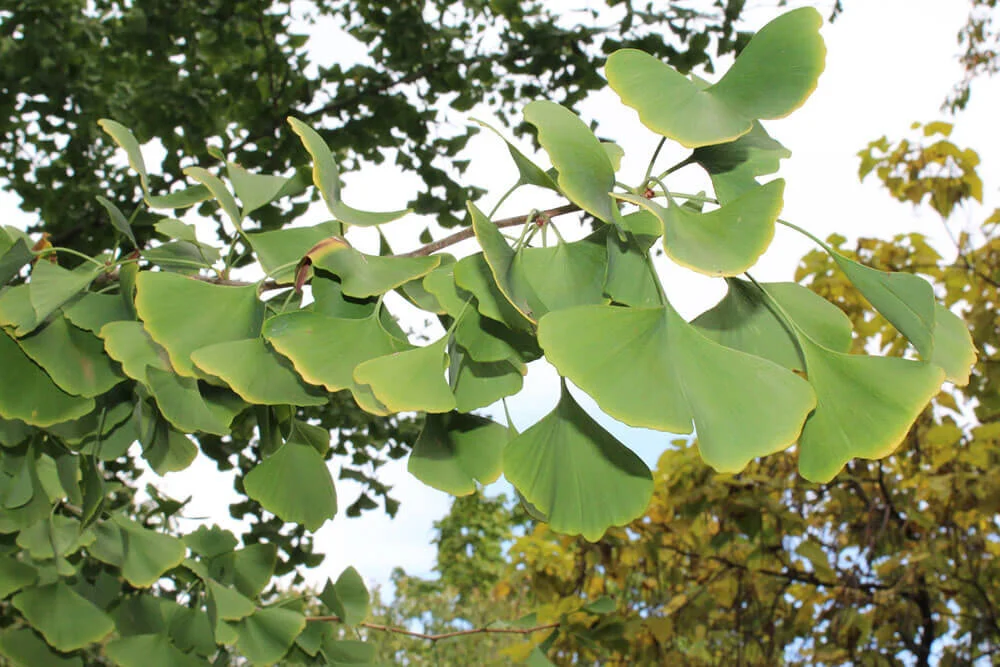The Ginkgo — A Unique Urban Tree
The Ginkgo tree is known for its distinctive fan-shaped leaves.
The Ginkgo is a tree is unlike any other, with some very unusual qualities that make it well suited for urban environments. Nashvillians may have noticed beautiful Gingkos around the city, from a huge specimen behind the Stephen Foster Apartments on Granny White Pike to a cluster near the Parthenon at Centennial Park.
You’ll soon see new Ginkgos along Shelby Avenue in East Nashville, since these trees are included in the planting plan for the new Shelby Avenue Arboretum. Two Presidential Gold Ginkgos will be planted at S. 9th Street and Shelby Ave. (If you’d like to volunteer to help with planting trees for the Arboretum, which launches this weekend, Nov. 14-15, find details here.)
A Ginkgo puts on a dazzling display of fall color in a Nashville parking lot.
A Tree With Superpowers
What makes the Ginkgo tree so special? And would this tree be a good addition to your yard? For starters, consider the fact that the Ginkgo is almost indestructible:
• Ginkgo trees originated in the Paleozoic Era (before dinosaurs), and survived the mass extinction event at the end of that era, which killed more than 90 percent of life on Earth. The Ginkgo may predate the conifers that originated at that time, which would make it the oldest living species of tree.
• The Ginkgo also survived a second mass extinction event: the meteor that struck the Yucatan Peninsula 66 million years ago, wiping out dinosaurs and about three-quarters of all life on Earth.
• A third example of the tree’s endurance occurred during World War II: the Ginkgo is widespread in Japan and was among the only species to survive the direct impact of the Hiroshima bombing. Ginkgo trees at the site were singed but otherwise unscathed and quickly recovered from their wounds.
A towering Ginkgo stands near Trinity Presbyterian Church on Hillsboro Road.
Ginkgos & Gender
But that’s not all! The Ginkgo also has some special biological characteristics:
• Ginkgos are dioecious, meaning they are one of the few trees that have both males and females. Male Ginkgo trees are favored for sidewalks and yards because they don’t produce the foul-smelling fruit that females do. Those fruits have health benefits though, and are highly valued for their nutrients and medicine. Female trees also don’t give off the pollen that males do, which can cause allergic reactions in people who live near them. To complicate things, when only males or only females are planted in a location, one of them may change to the other gender to be able to propagate.
• In the fall, Ginkgos lose all their leaves suddenly, at the same time, with the beautiful fan-shaped leaves collecting in yellow carpets beneath the trees. This striking display has inspired many poems, including a notable one by Howard Nemerov.
• The Ginkgo’s apparent tolerance to carbon-rich atmosphere has made it a great tree for cities, where it can withstand more pollution than many other species.
• Ginkgos are also strongly resistant to insects and fungus, an important quality for cities, where trees may have lower defenses than in wild areas. The devastating effects of beetle infestations like the Emerald Ash Borer and diseases like Dutch Elm have shown how losing large quantities of urban trees can be a blow to communities.
• Ginkgos are generally fast-growing trees and can live to be 1,500 years old.
• On the downside, the Ginkgo tree is not native — it was brought to American cities in the mid-19th century from China – and as a result, it does not support native species of wildlife.
Next time you’re outside, see if you can spot the ginkgo’s unique art-deco shaped leaves and columnar form somewhere in your neighborhood. It’s a tree worthy of our curiosity and attention.
For more information on the trees of the Nashville area (native and non-native) and how to care for them, sign up for our newsletter!



